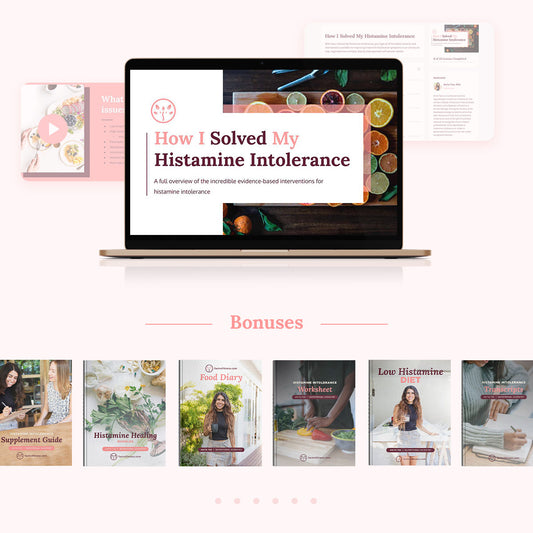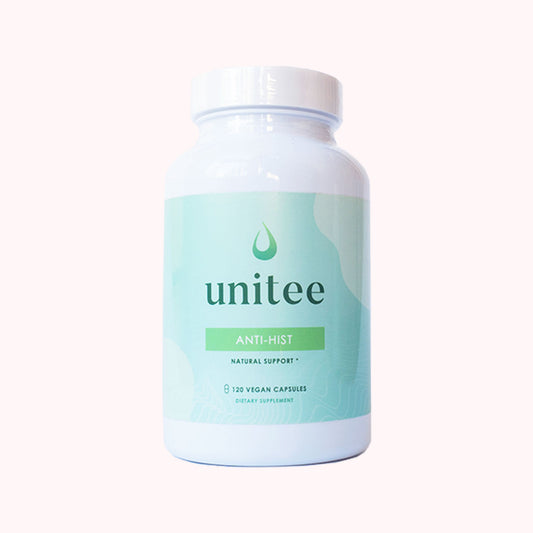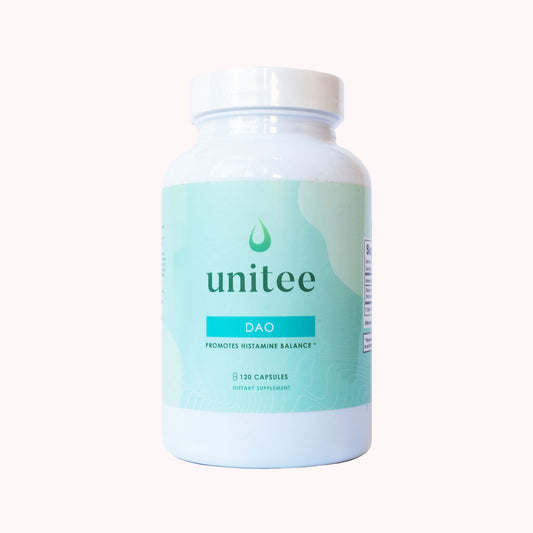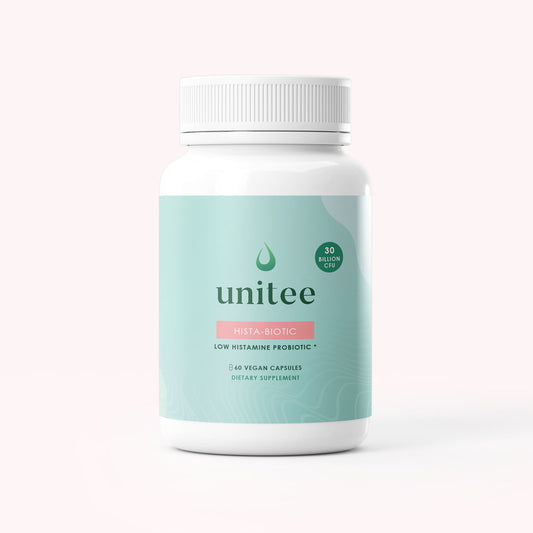I always get plenty of questions about histamine intolerance. From diet to supplements to what the heck can be done to fix the condition, and everything in between, it seems there is a lot of misinformation and general confusion about histamine intolerance.
Here, I've compiled a list of frequently asked questions to help you along your journey.
Let's dive in!
Answering Your Burning Histamine Intolerance Questions
Q: Why is histamine intolerance difficult to diagnose?
A: Histamine is present in every body system and is part of our naturally functioning immune system. This means that when there is an intolerance, it can impact any and all systems in the body. The range of symptoms that result can therefore mimic a whole whack of other conditions, and the symptoms that result from a histamine intolerance often first seem like they could be unrelated, which is what makes it so difficult to recognise and diagnose as one condition with a common cause.
Q: Can a person be histamine intolerant even if their blood histamine levels are normal during a flare?
A: Yes. This could very simply mean that they are unable to break down and/or handle normal levels. A person's tolerance to histamine, even when in the normal ranges, can be very low, and so even with seemingly normal histamine levels in the body, they can experience symptoms as a result. It's the reaction to the levels in the body that is most important to consider; if the receptors are very sensitive to the effect of histamine, even normal levels can cause undesirable symptoms.
Q: Is there a test you can do at home for testing histamine?
A: Yes! This test is cost effective, but we also recommend seeking additional guidance and monitoring by your health care practitioner to determine whether you are living with histamine intolerance or not.
To find out more about how you can go about determining whether you're affected by histamine intolerance, read this article: At home histamine intolerance test.
Q: Is SIBO (small intestinal bacterial overgrowth) a precursor for histamine intolerance? And, does Candida and gut dysbiosis go hand in hand with histamine symptoms? Recommendations?
A: Bacterial imbalances as well as the presence of unwanted microbes (yeast, bacteria, fungi, viruses) can absolutely throw off the gentle balance of histamine in the body. Not only can this lead to a decrease in the numbers of histamine degrading bacteria you have, but the microbes you have present in your gut could also be making their own histamine (1). Overall, the gut environment certainly has a significant role in creating increasingly high levels of histamine in your body. In an effort to regulate the diversity and cultures of microbes you have living in your digestive tract, thereby going about restoring the balance, it's important to use a low histamine probiotic like this one. Additionally, you can consider adding Saccharomyces boulardii capsules into the mix on top of your probiotic as this is a type of beneficial yeast that has proven to be helpful for histamine issues and is highly effective at fighting off candida and other yeasts. It also has another important function: it helps to regulate bowel movements, especially in those who experience diarrhea, and particularly when that diarrhea is associated with the use of antibiotics.
Here are a variety of resources you may find helpful:
Q: After following the anti-histamine diet for a week I’m feeling bloated, is this normal?
A: This can be completely normal. Take SIBO and candida as a cause of histamine intolerance, for example. When you begin to follow a low histamine diet, you're likely changing up the fuel you've been providing these bacteria, which have allowed them to survive. Removing sugar can cause these bacteria and yeasts to become distressed and begin dying off, which can create gas to be released as a result. Additionally, there are foods on the low histamine diet that you may have been avoiding, such as the cruciferous vegetables (broccoli, cauliflower, cabbage). If you've started eating them at this time, they may be causing digestive issues while your body adjusts to the changes in the nutrients they provide, like sulfur, for example. To begin with, you may want to cut back on these foods that are causing digestive distress or consume them in small amounts. It is normal to experience digestive discomfort when incorporating supplements and dietary changes for a few weeks. It's always best to talk to your healthcare professional before incorporating lifestyle and dietary changes, however, if the discomfort feels unbearable, or if it persists beyond 2-3 weeks, seek assistance from your healthcare provider.
Q: I’m not sure if I’m histamine intolerant. How long do you recommend trying the low histamine diet in order to see results?
A: My recommendation for following any new diet to see if it works is generally at least 3 weeks, but optimally 6 weeks. I know this can be a lot with the restriction of a low histamine diet, so if you're unable to manage 3-6 weeks, try at the very least two weeks. If you find it assists with symptoms or, if you feel you're sensitive to many of the restricted foods on this list, you'll know quite quickly that histamine is likely a culprit. After these couple of weeks, you'll get a pretty clear indication as to whether you have a histamine sensitivity if your symptoms reduce. At this point, you may want to consider looking into the histamine intolerance course, which explains all of the evidence-based interventions to help you to overcome histamine intolerance, helping you to discover the root cause, how to eat to lower your symptoms of histamine intolerance as well as which supplements are likely to help you at each step of the way (2).
Take a look at the course here: How I Solved My Histamine Intolerance Course
Looking For Answers For Your Histamine Intolerance Diet Questions? Here They Are!
Q: I’m confused about histamine ‘safe’ foods, is there a list?
A: I have spent a significant amount of time looking at all of the available food lists and evidence relating to foods that may trigger histamine intolerance. With this information, I have compiled a comprehensive histamine intolerance food list that provides safe and bothersome foods in every different food category. My suggestions is that you follow the low histamine diet, eating only foods on the safe list for at the very least 2 weeks to see if you notice any improvement in your symptoms. If you do, you're likely living with a histamine intolerance. Additionally, you can use any recipes in the Low Histamine Cookbook Bundle which contains 170 low histamine recipes that are all safe for the low histamine diet!
Find out more here:
Q: Are garlic and onions high in histamine?
A: Garlic and onions are usually okay when it comes to histamine intolerance. Should you react to them, you may be struggling with the sulfur content that they contain, which should resolve as you include more sulfur in your diet. Another reason you may be struggling with onions and garlic is as a result of salicylate intolerance. The symptoms can present very similarly to histamine intolerance, but the food lists are very different. In the case of histamine intolerance, garlic is actually recommended for its antioxidant and anti-inflammatory properties (3). Before cutting them from your diet completely should you feel that they are bothersome, try chopping them very finely and sauteeing them before adding them to your meals.
Q: Is the low histamine diet okay for vegans; considering most legumes and nuts are meant to be removed?
A: Soy, beans and legumes are okay, if tolerated. Many people have issues digesting these which is why they have been restricted. If you are certain they do not give you digestive distress, then you may proceed with them. However, it is best to keep nuts removed due to their high histamine content.
Q: Any recommendations low histamine protein powders or bars?
A: We do not currently sell a histamine-specific protein bar or powder, nor do we work with or have a list of approved brands that do. While there are some low histamine options for protein powders that we find many people with histamine intolerance tolerate, such as hemp protein and pumpkin seed protein, it is always best to keep in mind that whole food sources are your best chance at increasing protein in your diet. Low in histamine whole food sources of protein include fresh meat and poultry, fresh fish and cooked eggs.
Q: Are camel’s milk or goats milk ‘safe’ alternatives to dairy?
A: Goat’s milk is a good alternative, if tolerated. The same would be recommended for camel’s milk. If tolerable by your system, both are welcome.
Q: What if I don’t see or feel improvements on the low histamine diet?
A: If you do not see improvement on the low histamine diet, your issues may not be histamine related. Or, it could mean that you have additional intolerances and you haven't eliminated all of the offending foods yet.
There might be many other reasons you're experiencing symptoms. Two closely related intolerances that are often confused with histamine intolerance are salicylate intolerance and oxalate intolerance, which could also be potential issues.
If you do feel better but not dramatically, it may be worth eliminating high oxalate and/or salicylate foods, too.
Q: Since olives are high in histamine, does this mean that olive oil should also be avoided?
A: Olive oil is absolutely accepted, and even helpful! Olive oil, in fact, can increase the activity of diamine oxidase (DAO), a histamine degrading enzyme, by up to 500%! However, typical olives themselves are fermented and high in histamine.
Q: When can I start adding high histamine foods back in?
A: Everyone is on a different timeline due to their symptoms and healing, however, there is further guidance that can be found on food reintroduction in this post: Histamine intolerance test.
Q: Is intermittent fasting recommended on a low histamine diet?
A: Intermittent fasting has shown excellent benefits for health and overall wellness – 16 hours fasting and 8 hours for eating is highly recommended! If this window of fasting seems daunting or you struggle with blood sugar imbalances, start with a 12 hour fast and work your way up to 16 hours over the course of a few weeks (4).
Q: Is bone broth high in histamine?
A: As bone broth is required to be slow-cooked, during the slow cooking process bone broth increases in histamine levels through conversions of histidine to histamine. However, depending on your tolerance, you may be able to consume very fresh bone broth that hasn't been cooked for more than 8 hours, as bone broth is extremely beneficial for gut health and healing.
Q: How long do cooked and fresh foods stay tolerable?
A: The duration that people can tolerate after cooking depends on individual sensitivity. Some people can tolerate it 24 hours after cooking or more, whereas for other people, they will have a reaction to the same food that has been refrigerated even for a shorter time. In general, I do not generally recommend consuming leftovers - especially high protein leftovers such as meat, fish or eggs. If you do find that it is difficult to cook every meal, freezing leftovers may be an option, and then thawing them in the fridge. That being said, however, overall, my recommendation for the best option is to eat fresh as much as possible.
Q: I have trouble getting fresh meat and fish - can I freeze it?
A: Absolutely! Meat and fish that is frozen from fresh is absolutely fine. My recommendation is to ask your local grocer what day the meat gets delivered and purchase your meats on that day. Then, portion and freeze the meats directly and thaw them the day of cooking. Remember to thaw all foods in the fridge where possible, as this will ensure maximum freshness is preserved while making the process more convenient!
What About Histamine Intolerance Supplements?
Q: Are DAO supplements helpful?
A: DAO supplements can be very helpful, especially because they specifically target histamine that is ingested (5). DAO therefore helps to control environmental and dietary histamine exposures.
It's important to keep in mind that DAO breaks down incoming histamine (ie. through diet), but does not act on internally produced histamine (ie. from mast cell release). For this reason, I always aim to combine DAO with my all natural antihistamine called Anti-Hist, which is far more helpful to histamine intolerance sufferers that struggle with internal production of histamine, and it offers greater and faster results. With this combination, my clients report being able to eat more foods with less symptoms in as little as 2 weeks!
Q: Is this antihistamine supplement safe for those with citrus sensitivities and allergies?
A: Yes. The ascorbic acid is derived from the fermentation of glucose from corn (not citrus) and is considered non-GMO under the European Union guidelines.
Q: Who is this antihistamine supplement beneficial for?
A: The Anti-Hist supplement is beneficial for those experiencing dietary reactions due to histamine, and for those who are intolerant to histamines in general. It's benefit is not limited to those who struggle with histamine that is derived from environmental allergens only.
Q: When should I take this antihistamine supplement?
A: We recommend 15-30 minutes before eating.
Q: How long can I take this antihistamine supplement?
A: You can take the recommended dose of Anti-hist on an ongoing basis. You can gradually try to reduce the dosage down to one per day or even one per day on the days you're eating high histamine foods as your tolerance increases.
Q: I’m having issues with mast cell activation syndrome. Any recommendations?
A: The best recommendation is Anti-Hist. It specifically stabilizes mast cells and most people who use it report being able to eat more foods with fewer symptoms. Some have even referred to this supplement as their “miracle in a bottle”.
Q: What is a good omega 3 supplement?
A: I recommend this one for my histamine intolerant clients: EPA/DHA
Q: When should I take my low histamine probiotic and how many per day?
A: 1 capsule, twice daily. Taking it 30 minutes before breakfast and dinner usually work best.
Q: Is turmeric helpful for histamine intolerance? If so, any recommended supplement brands?
A: Curcumin, the active ingredient found in turmeric, has been shown to be extremely helpful for reducing inflammation, and can absolutely be beneficial for histamine intolerance (6). However, curcumin has a very low bioavailability - meaning that it's not readily available for your body to use unless it's combined with specific ingredients. This is why you should be wary of buying cheap turmeric supplements, which can be a waste of money and even harmful if the capsules aren't clean. I recommend using this curcumin supplement, as it contains all of the ingredients to enhance bioavailability in the body and has an extremely clean capsule.
Q: What should I take if I have H. pylori or other parasites/bad bacteria?
A: My recommendation, especially for those with H. pylori - which is a very common underlying cause of histamine intolerance - is a natural supplement called Pyloricil. I've done the research on the components that make this produce and found that Pyloricil's ingredients work effectively against H. pylori, including antibiotic-resistant H. pylori. All without some of the harmful side-effects that you may get with other options. Pyloricil is effective against numerous bothersome bacteria and the ingredients benefit your body overall.
Q: How long should I take an H. pylori supplement for?
A: Pyloricil can be taken for a maximum of 4-8 weeks (which will be 1-2 bottles). If you need it in the future, you can cycle it back into your routine again.
Q: Are collagen and gelatin recommended to improve gut health?
A: Yes, but some people with histamine intolerance cannot tolerate them. It is important to find what works for your body and symptoms. You can certainly try one or the other, or both, and depending on how you react, you can choose to include or exclude them from your diet.
Q: Recommendations to regulate bowels?
A: Keeping a healthy gut is one of the best ways to regulate your bowels. This starts with using the right low histamine probiotic. and adding a diversity of low-histamine fiber-rich vegetables to your diet. Often, those with histamine intolerance are on a very limited diet, eating mostly meat and carbs, which are both low in fiber. Using my low histamine food list, as well as the probiotic, we can get your bowel back on track and regular.
References:
- Schnedl WJ, Enko D. Histamine Intolerance Originates in the Gut. Nutrients. 2021;13(4):1262. Published 2021 Apr 12. doi:10.3390/nu13041262
- Sánchez-Pérez S, Comas-Basté O, Veciana-Nogués MT, Latorre-Moratalla ML, Vidal-Carou MC. Low-Histamine Diets: Is the Exclusion of Foods Justified by Their Histamine Content?. Nutrients. 2021;13(5):1395. Published 2021 Apr 21. doi:10.3390/nu13051395
- Kyo E, Uda N, Kakimoto M, et al. Anti-allergic effects of aged garlic extract. Phytomedicine. 1997;4(4):335-340. doi:10.1016/S0944-7113(97)80043-8
- Nakamura S, Hisamura R, Shimoda S, Shibuya I, Tsubota K. Fasting mitigates immediate hypersensitivity: a pivotal role of endogenous D-beta-hydroxybutyrate. Nutr Metab (Lond). 2014;11:40. Published 2014 Aug 28. doi:10.1186/1743-7075-11-40
- Schnedl WJ, Schenk M, Lackner S, Enko D, Mangge H, Forster F. Diamine oxidase supplementation improves symptoms in patients with histamine intolerance. Food Sci Biotechnol. 2019;28(6):1779-1784. Published 2019 May 24. doi:10.1007/s10068-019-00627-3
- Li X, Lu Y, Jin Y, Son JK, Lee SH, Chang HW. Curcumin inhibits the activation of immunoglobulin e-mediated mast cells and passive systemic anaphylaxis in mice by reducing serum eicosanoid and histamine levels. Biomol Ther (Seoul). 2014;22(1):27-34. doi:10.4062/biomolther.2013.092

Anita Tee
My name is Anita Tee. I'm a nutritional scientist who specializes in histamine intolerance. I hold a Master of Science in Personalized Nutrition and a Bachelor of Science in Human Biology and Psychology. For the past ten years, I have used my experience in nutritional and medical health sciences to create a scientifically backed, natural approach to healthcare that relies 100% on evidence-based research. As I previously suffered from - and overcame - histamine intolerance, my focus is to increase recognition and expand the available resources and protocols available for resolving this particular disorder. To date, I have helped over 4,000 individuals fully resolve or better manage their histamine intolerance symptoms.







